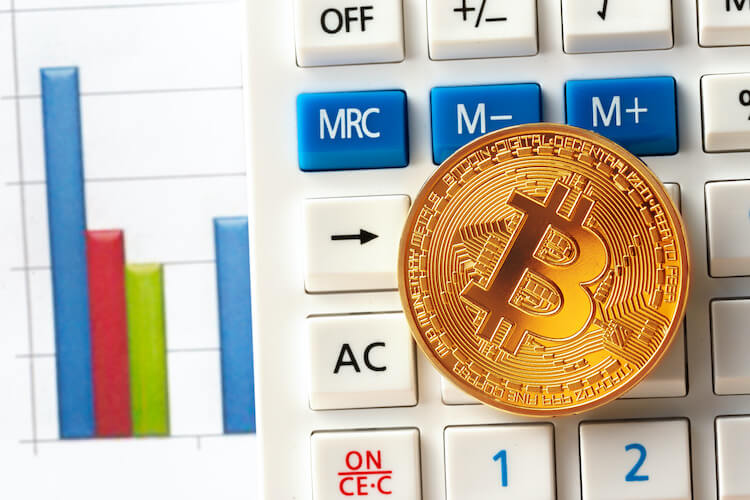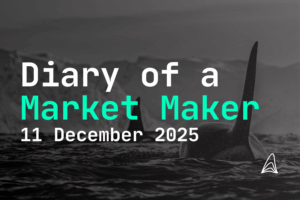
What is Crypto Arbitrage and Bitcoin Arbitrage Trading?
- Jakob Brezigar
- Last updated: 05.February 2024
- Reading time: 8 min
Imagine being at a party where Bitcoin sips cocktails at one price on the patio and, just a few steps away in the kitchen, enjoys them for a bit less. Welcome to the world of crypto arbitrage, where traders party by hopping between these ‘rooms’ to sip on price differences. Arbitrage in crypto is simply the practice of buying a cryptocurrency on one exchange where the price is lower and selling it on another where the price is higher, turning a profit on the spread.

Table of Contents
What is crypto arbitrage?
Crypto arbitrage involves exploiting price differences of a cryptocurrency across different exchanges. Traders buy low on one exchange and sell high on another to profit from the disparity.
What are the main types of crypto arbitrage?
There are several types, but the most common are spatial arbitrage (between exchanges), temporal arbitrage (time-based), and triangular arbitrage (using three different cryptocurrencies).
What challenges exist in crypto arbitrage?
Challenges include exchange fees, withdrawal limits, transaction delays, liquidity constraints, and potential tax implications.
Key Takeaways
- Crypto arbitrage exploits price discrepancies across exchanges, buying low and selling high, with cross-exchange and triangular strategies being common methods.
- Centralized exchanges use order books for pricing, offering clear arbitrage opportunities, while decentralized exchanges (DEXs) rely on AMMs, creating different arbitrage scenarios.
- Automated trading bots are increasingly used for their speed and efficiency in executing arbitrage strategies across multiple exchanges.
- Despite being considered low-risk, crypto arbitrage involves challenges like market volatility, exchange fees, and potential technical issues affecting profitability.
- Starting in arbitrage trading requires understanding market dynamics, exchange fee structures, and using real-time tracking tools to spot opportunities.
Is Triangular Arbitrage Better Than Cross-Exchange Arbitrage in Crypto Trading
At Orcabay, we’ve extensively employed both triangular and cross-exchange arbitrage strategies in our crypto trading endeavors, aiming to capitalize on price discrepancies across different markets. In a notable case, we utilized triangular arbitrage within a single exchange by exploiting price differences between three cryptocurrencies. Although profitable, this strategy often yielded lower returns compared to our cross-exchange arbitrage efforts. For instance, by simultaneously buying a cryptocurrency on Exchange A where it was undervalued and selling it on Exchange B where it was overvalued, we significantly amplified our profits. This disparity in profitability led us to favor cross-exchange arbitrage. Recognizing the efficiency and speed required to maximize these opportunities, Orcabay has increasingly relied on automated crypto arbitrage. Our bots excel in executing these strategies, seamlessly navigating multiple exchanges and executing trades with precision that far surpasses manual trading methods. This technological leverage has not only optimized our arbitrage strategies but also consistently delivered higher returns, solidifying our preference for cross-exchange arbitrage in the volatile crypto market.
Centralized Exchanges
Centralized exchanges, like Kraken or Coinbase, are platforms that operate under a central organization, facilitating the buying and selling of crypto assets. How these exchanges calculate cryptocurrency prices is quite systematic. They employ a method called an order book.
It’s essentially a list that captures all buy and sell orders for a given asset. When trading crypto assets on a centralized exchange, one can visualize the demand and supply and identify where arbitrage opportunities might lie.

Decentralized Exchanges
Decentralized exchanges (DEXs) are in stark contrast to their centralized counterparts. They operate without a central authority and instead utilize smart contracts and automated processes to execute crypto arbitrage trades.
Examples of such platforms include Uniswap and Balancer. Users on these platforms often interact with the platform’s liquidity pools rather than trading directly with other users, making it a hotbed for decentralized arbitrage traders.

Pricing on Centralized Crypto Exchanges (Order Book)
On centralized exchanges, the pricing of a crypto asset is influenced by multiple factors. It’s primarily determined by the most recent trading price. The order book provides a clear picture, listing the highest bid (buy order) and the lowest ask (sell order).
These values help in determining real-time asset prices. Savvy crypto arbitrage traders always keep a close eye on these order books to spot price discrepancies, which lead to lucrative arbitrage opportunities.
Decentralized Arbitrage
Decentralized arbitrage is the practice of taking advantage of price differences between various DEXs. It’s a trading method that has grown in popularity with the rise of decentralized exchanges in the crypto world. Given the decentralized nature of these platforms, traders can potentially save on exchange fees and maintain greater control over their assets during transactions.
Cryptocurrency arbitrage opportunities on decentralized platforms are abundant, mainly because differences in prices can arise due to differences in trading volume or how exchanges interact with liquidity pools.
Triangular arbitrage is a more sophisticated form of arbitrage trading. This strategy involves leveraging price differences between three different cryptocurrencies or the same asset but across different markets. It’s typically executed on a single exchange but can also span across multiple exchanges. The goal here is to capitalize on pricing inefficiencies that exist among three different trading pairs.
For instance, a trader buys crypto asset A with asset B, then trades asset A for asset C, and finally exchanges asset C back for asset B. If done correctly, the trader ends up with more of asset B than they started with.
Unlike centralized exchanges that rely on order books, DEXs often use Automated Market Makers (AMMs). These are essentially liquidity pools backed by algorithms. The price of a crypto asset within an AMM is determined by the balance of assets in its pool. Such a system means that asset’s price can fluctuate based on supply and demand in that specific pool.
This creates a scenario where pricing discrepancies can occur between AMMs and centralized exchanges or even among different AMMs, presenting decentralized arbitrage opportunities.

When diving into the world of crypto arbitrage trading, one encounters various strategies. These include spatial arbitrage, where price differences of a cryptocurrency are exploited between two exchanges, and flash loans, which involve borrowing funds to take advantage of arbitrage opportunities without the need for collateral. Each strategy caters to different marke fts and trader expertise levels.
Engaging in crypto arbitrage trading might sound simple, but it demands a deep understanding of the crypto market, potential profit margins, and the nuances of various platforms. To execute trades efficiently, one needs real-time tracking tools, a clear understanding of fees, and knowledge about transaction times across platforms.
Furthermore, delving deeper into crypto trading reveals the significance of being adept at discerning price differences across a variety of trading pairs. Exchange fees can vary, and understanding their structure is pivotal for maximizing profits. It’s also noteworthy that the community of cryptocurrency arbitrage traders continuously expands, with many leveraging their expertise in selecting the right trading pair at the perfect moment.
As with all forms of trading, the devil is in the details, and mastery comes with experience and dedication.

While crypto arbitrage is often considered a relatively low-risk trading strategy, especially when compared to traditional markets, it’s not devoid of challenges. Market volatility can rapidly erode potential profits. Also, there are considerations like trading fees, potential withdrawal fee, deposit and withdrawal delays, and the ever-present risk of one exchange going offline temporarily or facing technical issues.

Different exchanges offer varying crypto asset prices. Factors like trading volume, regional demand, how exchanges interact with their liquidity pools, and even time of day can affect these prices. Not all exchanges will have the same price for Bitcoin, Ethereum, or any other crypto assets, creating a playground for crypto arbitrageurs to thrive.
In the expansive realm of crypto assets, a keen-eyed crypto arbitrage trader recognizes the subtleties of each crypto exchange, considering variables like withdrawal fees that might impact the overall profitability of a trade. The principle behind this hinges on the free market, where supply and demand determine asset values. As such, a particular exchange might have a higher demand for a particular cryptocurrency, pushing its price slightly higher than another exchange.
Such nuances in the marketplace offer savvy traders an avenue to capitalize on.
Crypto arbitrage traders have one primary goal: to exploit discrepancies in prices across various exchanges. They constantly monitor differences in prices, ensuring they buy low and sell high. These traders often use trading bots to automate the process, given the speed at which crypto prices can change.
Diving deeper into the intricacies of crypto trading, some engage in triangular arbitrage, which involves using three different cryptocurrencies on either decentralized exchanges or traditional cryptocurrency exchanges to capitalize on price imbalances. This method requires a comprehensive understanding of the market and a meticulous eye for detail, as it involves not just two, but three trading pairs.
Despite the complexities, the dynamism of decentralized exchanges and the evolution of exchanges for cryptocurrencies in general present numerous opportunities for those adept in navigating the volatile landscape.

For those new to arbitrage trading, starting can seem daunting. But it boils down to understanding the cryptocurrency markets, familiarizing oneself with different exchanges for cryptocurrencies, and recognizing the role of trading fees. Real-time tracking tools are essential, as is a keen eye for spotting arbitrage opportunities as they arise.
Such arbitrage is a trading strategy that revolves around exploiting the price differences of a cryptocurrency on two different exchanges. For instance, if the price of Bitcoin is lower on Exchange A compared to Exchange B, a trader buys Bitcoin on Exchange A, transfers it to Exchange B, and sells it at the higher price.

Flash loans are unique to the decentralized finance (DeFi) realm. These are essentially uncollateralized loans where borrowing and repayment occur within a single transaction. Arbitrage traders use flash loans to exploit price discrepancies without the need for upfront capital.
Compared to other trading strategies in the financial markets, crypto arbitrage is seen as low-risk because it doesn’t rely on predictions of future market movements. Instead, it capitalizes on existing discrepancies in prices across exchanges.
Essentially, the approach is rooted in real-time data, taking advantage of current market conditions rather than speculating on potential future shifts. As it’s grounded in tangible present disparities, it often provides traders a clearer path to profitability. Additionally, as it operates on brief windows of opportunity, traders are typically exposed to the volatile cryptocurrency market for a shorter duration, further minimizing potential adverse impacts.
This real-time, data-driven approach contrasts sharply with other trading strategies that may involve higher degrees of speculation and, consequently, risk.

Fees are a crucial consideration in crypto arbitrage. Platforms might charge for deposits, trading, and withdrawals. High fees, especially on centralized exchanges, can significantly reduce the potential profits from arbitrage trades.
Such scenarios can hinder arbitrage trading. For instance, if a multisig wallet on one exchange is offline due to maintenance or is on a different blockchain, it can delay transfers, impacting the efficacy of an arbitrage opportunity.
When this happens on a centralized exchange, traders may feel the pinch as these platforms usually have a dedicated infrastructure for specific assets, ensuring seamless trades. Contrastingly, in environments where smart contracts play a pivotal role, like certain blockchain platforms, the same asset could have multiple representations across chains, complicating the process further.
Imagine trying to trade a vintage item in a dedicated vintage marketplace, but the item is momentarily inaccessible or in a different format; the situation for traders becomes equally perplexing.

All these fees can eat into the potential profit margins of arbitrage trades. It’s crucial for traders to be aware of all costs involved in their trades to ensure profitability. Specifically, when engaging in crypto trading on a decentralized exchange, traders may encounter different fee structures compared to traditional platforms.
These can include deposit and withdrawal fees, which are sometimes variable based on network congestion. Moreover, transaction fees on blockchain networks, especially during peak times, can unpredictably spike.
Therefore, staying informed about the fee landscape, and particularly understanding how each decentralized exchange structures its costs, becomes pivotal for traders looking to optimize their trading strategy and maximize returns.

Modern-day traders use tools to simplify their trading endeavors. Automated crypto arbitrage trading involves the use of bots that can monitor and execute trades across multiple exchanges in real-time. This provides a significant advantage, given the rapidity with which cryptocurrency prices can fluctuate.

Crypto arbitrage trading has carved a niche for itself in the expansive world of cryptocurrency trading. While it presents numerous opportunities for potential profit, like all trading strategies, it’s not without its challenges. It requires a deep understanding, quick decision-making, and constant vigilance to stay ahead in the game. As the crypto markets continue to evolve, so will the strategies and tools available to traders, making the future of crypto arbitrage trading an exciting prospect.

Jakob Brezigar
Jakob, an experienced specialist in the field of cryptocurrency market making, boasts an extensive international presence. With Orcabay, he has skillfully managed major operations and deals for a wide array of global stakeholders.



